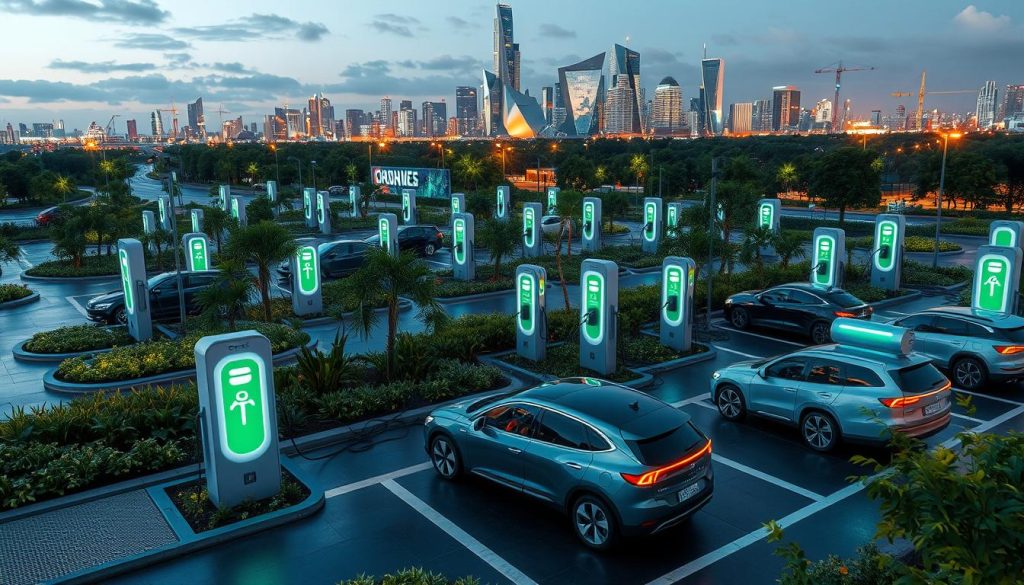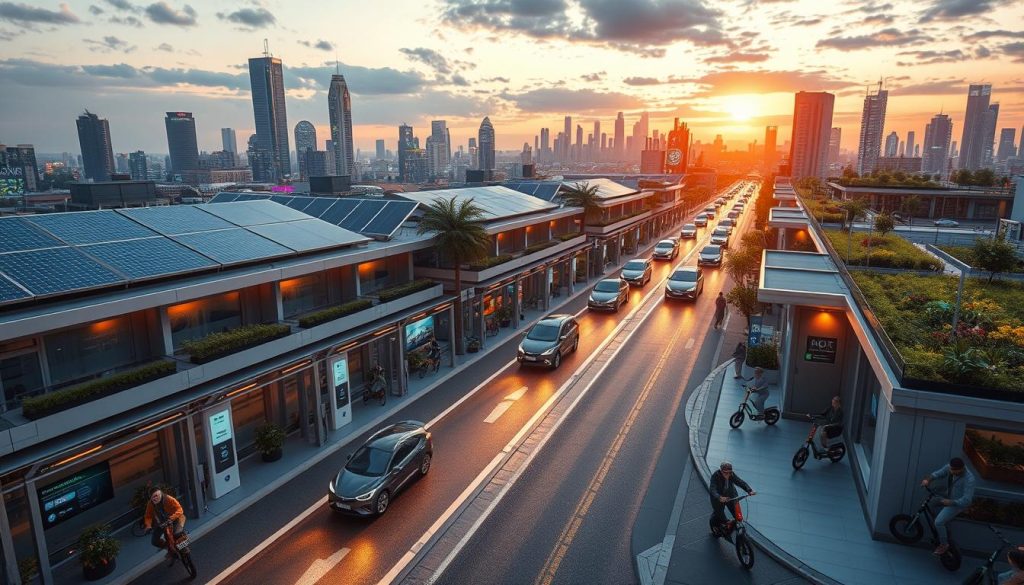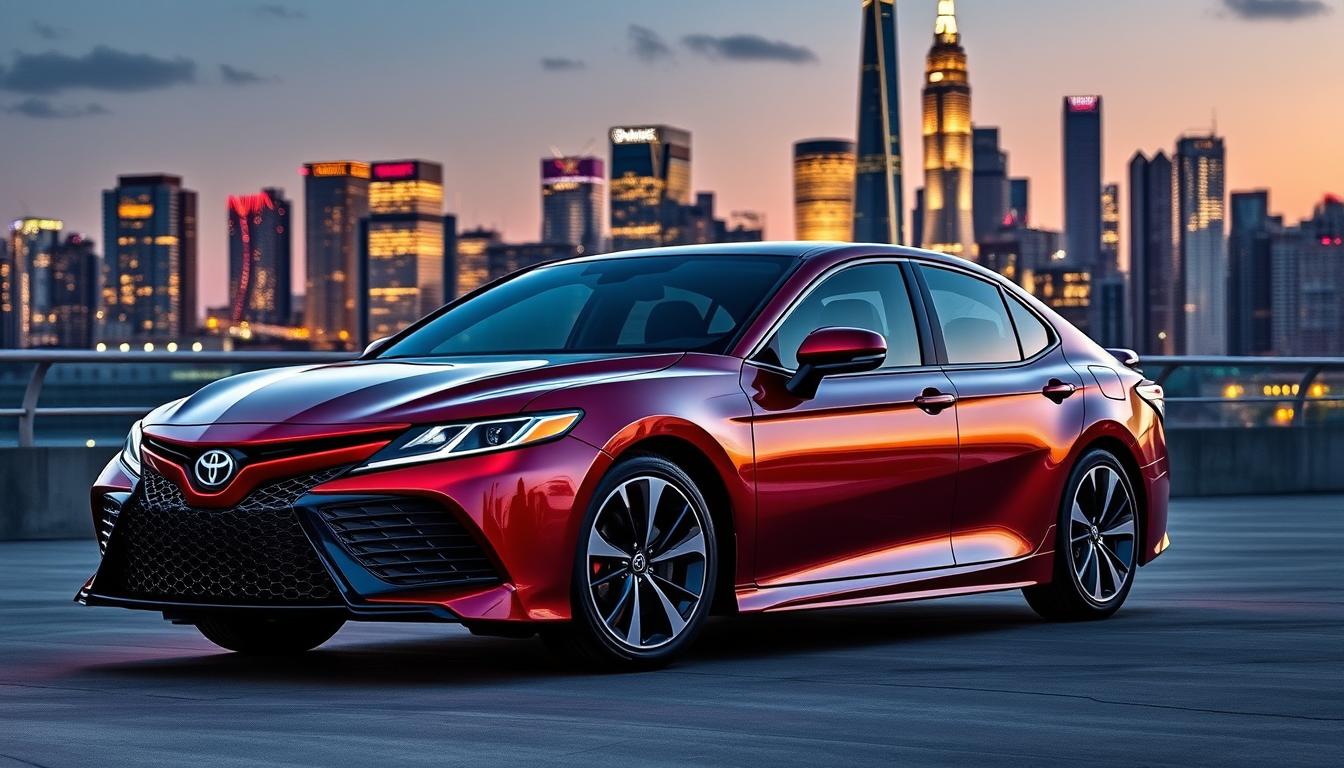Electric Vehicles: The Future of Sustainable Transportation
We’re seeing a big change in how we travel. Electric vehicles are leading the way to a cleaner future. In the U.S., cars and trucks cause about 35% of all CO2 emissions. So, moving to greener transport is key.
Electric cars are a better choice than traditional ones. They don’t have tailpipes, so they don’t release harmful gases. This helps make our cities’ air cleaner.
Electric cars are also more efficient than gas cars. They use more of the energy they get to move. As battery tech gets better, they can go even farther on one charge.
Cities everywhere are getting on board with electric cars. Fast-charging stations are appearing on streets and highways. Some electric cars can even send power back to the grid when needed.
Looking ahead, electric cars will be even more important. By 2032, 30% of all cars worldwide could be electric. This change is good for our planet and will change how we travel and live.
The Rise of Electric Vehicles
Electric vehicles are changing the car world. We’ve seen a big jump in electric car sales and EV market growth lately. Let’s explore the history and recent trends of electric vehicle adoption.
Historical Overview of Electric Vehicles
Electric cars have been around since the 19th century. But, it’s only recently that they’ve become more popular. The first modern electric car was made in 2010, starting a big change in the auto industry.
Recent Trends in Electric Vehicle Adoption
The growth of the EV market is amazing. In 2023, over 14 million electric cars were sold globally. This made up 18% of all car sales, a big increase from 2020’s 4%.
China is leading in electric car adoption. In 2023, it had 60% of new electric car registrations, with 8.1 million new EVs. The United States and Europe also saw big growth, with over 40% and 20% increases respectively.
| Region | New EV Registrations (2023) | Growth from 2022 |
|---|---|---|
| China | 8.1 million | 35% |
| Europe | 3.2 million | 20% |
| United States | 1.4 million | 40% |
Other countries are also starting to use electric cars. India saw a 70% increase in electric car registrations. Thailand and Vietnam also saw huge growth. This trend is expected to keep going, with over 20% of new cars sold in 2024 being electric.
The rise of electric vehicles is changing how we drive and use energy. By 2030, EVs could cut oil demand by nearly 6 million barrels per day. As electric car sales keep rising, we’re seeing a big shift towards green transportation.
Environmental Benefits of Electric Vehicles
Electric vehicles (EVs) are leading us towards a cleaner future. They play a key role in reducing greenhouse gas emissions and improving air quality. Let’s look at how these eco-friendly vehicles are positively impacting our environment.
Reduction in Greenhouse Gas Emissions
EVs cut down greenhouse gas emissions a lot compared to traditional vehicles. In the United States, the transportation sector uses about 30% of total energy and 70% of petroleum. Switching to electric vehicles can greatly reduce our carbon footprint.
Electric cars are very efficient. They get over 130 MPGe and use only 25-40 kWh per 100 miles. This means they emit less, especially in areas with cleaner electricity.
Decreased Air Pollution Levels
EVs help improve air quality by not having tailpipe emissions. Unlike regular vehicles, they don’t release harmful pollutants like carbon monoxide and nitrogen oxides. This is especially good for urban areas where air pollution is a big problem.
| Vehicle Type | CO2 Emissions | Air Quality Impact | Lifecycle Advantage |
|---|---|---|---|
| Electric Vehicles | Zero tailpipe emissions | Significant improvement | Yes, in low-polluting energy regions |
| Hybrid Electric Vehicles | Reduced emissions | Moderate improvement | Yes, due to higher efficiency |
| Conventional Vehicles | High emissions | Negative impact | No |
With more people choosing EVs, we’re seeing big steps towards reducing carbon footprints. For example, Norway had almost 80% of new car sales as EVs in 2021. This shows how we can make a difference globally.
Key Technologies Behind Electric Vehicles
Electric vehicles (EVs) are changing the car world. We’ll look at the latest tech in EVs, focusing on batteries and charging.
Battery Innovations and Their Impact
The heart of an EV is its battery. Lithium-ion batteries are leading because they pack a lot of power in a small package. This lets EVs go further on one charge and stay powerful longer.
Some EVs can now go over 300 miles on one charge. New tech is coming. CATL’s Qilin battery could go 1,000 kilometers on one charge. Tesla wants to make batteries cheaper and smaller by 55% and 35%, respectively.
Charging Technologies: Fast and Convenient Options
Fast-charging stations are key for EVs to become more popular. There are three main types of charging:
- Level 1: Adds about 5 miles of range per hour
- Level 2: Provides roughly 25 miles of range per hour
- Level 3 (DC fast charging): Delivers 100 to 200+ miles in just 30 minutes
China is leading in building more charging stations. This is helping EVs become more common in the country.
| Charging Level | Range Added per Hour | Typical Use |
|---|---|---|
| Level 1 | 5 miles | Home charging |
| Level 2 | 25 miles | Workplace, public spaces |
| Level 3 (DC Fast) | 200+ miles in 30 min | Long-distance travel |
As EV tech gets better, we’ll see faster charging and longer ranges. This makes electric cars more appealing to people.
Comparing Electric Vehicles to Traditional Cars
Looking at EVs and gas cars, we see big differences. Electric vehicles are changing how we travel. They offer benefits that gas cars can’t match.
Cost Savings Over Time
EVs might cost more upfront, but they save money in the long run. By September 2023, the price gap between EVs and gas cars was just $2,800. Plus, federal tax credits of up to $7,500 make EVs more affordable.
When it comes to fuel, EVs are a big win. EV drivers spend 60% less on fuel each year than gas car drivers. On average, EVs cost $485 a year to fuel, while gas cars cost $1,117.
Maintenance Differences and Benefits
EVs also win when it comes to maintenance. With fewer parts, EVs cost half as much to fix and maintain as gas cars. This means less time and money spent at the mechanic.
| Aspect | Electric Vehicles | Gas-Powered Cars |
|---|---|---|
| Annual Fuel Cost | $485 | $1,117 |
| Maintenance Cost | 50% less | Baseline |
| Efficiency | 2.6-4.8 times more efficient | Baseline |
| 7-Year Net Savings | $7,000 – $11,000 | Baseline |
The numbers show EVs save a lot of money over time. A 2024 study found EVs are cheaper than gas cars over seven years. This makes EVs a smart choice for those looking to save money.
The Role of Government Policies
Government policies are key in making electric vehicles (EVs) more popular. Over 1 million EVs were sold in the U.S. in 2023. This growth is thanks to smart policies and subsidies that make EVs more appealing.
Incentives for Electric Vehicle Buyers
EV tax incentives help boost EV sales. The Clean Vehicle Tax Credit can give up to $7,500 off certain EVs. This makes EVs more competitive with gas cars.
States also offer their own perks. Some give extra rebates or let EV owners use HOV lanes. These federal and state incentives can lower the cost of buying an EV.
Regulations Promoting Electric Vehicle Production
The government is also pushing for more EVs to be made. The Bipartisan Infrastructure Law put $5 billion into a project for more EV charging stations. This is a big step towards making EVs more accessible.
Car makers are also being influenced. New rules could make EVs 67% of all new car sales soon. This is driving more investment and innovation in EVs.
| Policy | Impact |
|---|---|
| Clean Vehicle Tax Credit | Up to $7,500 savings on EV purchase |
| National Electric Vehicle Infrastructure | $5 billion investment in charging networks |
| Proposed Emission Standards | 67% of new vehicle sales to be EVs |
These policies are changing the car industry. They’re pushing for more innovation and a shift to green transport. As we go on, government support will be key to making EVs even more popular.
Challenges Facing Electric Vehicle Adoption
Electric vehicles (EVs) are becoming more popular. But, there are still big hurdles to overcome. We’ll look at the main challenges and myths about EVs.
Infrastructure Needs for Widespread Use
One big problem is the lack of EV charging spots. McKinsey & Company says charging issues are the biggest worry for people thinking about buying EVs in the U.S. They worry about slow charging, not enough chargers, and the cost of chargers.
The charging network can’t keep up with the demand. Level 3 chargers can give 100 miles of range in about 40 minutes. But, they’re not everywhere yet. This makes people worried about running out of charge.

Common Misconceptions and Myths
Many myths about EVs slow down their adoption. One myth is that EVs are too pricey. But, EVs are often cheaper in the long run because they need less maintenance and fuel.
Another myth is that there aren’t enough EV models. But, the EV market is growing fast. Right now, there are 29 fully electric car models in North America, with more coming.
- Myth: EVs have insufficient range for daily use
- Fact: Modern EVs can cover 200-300 miles on a single charge
- Myth: Charging is always slow and inconvenient
- Fact: Fast-charging stations are becoming more common
It’s important to tackle these challenges and clear up myths. This will help EVs become more popular and make our transportation greener.
Charging Infrastructure: Where We Stand
The growth of EV charging stations is key for more electric cars. We’re seeing fast-charging networks grow in cities and on highways. But, there are still big challenges.
Current Charging Network Overview
The U.S. Office of Energy Efficiency and Renewable Energy says there are 161,562 public and private EV charging stations. Only 6,409 are DC fast charging stations. This lack of charging spots is a big problem for electric cars.
A 2022 Consumer Report survey found 61% of people see charging as a big issue when buying an EV. The Autolist survey in 2023 also showed concerns. 39% worry about range, and 33% worry about charging logistics.
Future Expansion Plans for Charging Stations
The Edison Electric Institute predicts a big increase in EVs in the U.S. From 2.4 million in 2021 to 26.4 million by 2030. We’ll need about 12.9 million charge ports and 140,000 DCFC ports.
We’re investing in smart grid tech and energy storage to make the grid more stable. Future plans focus on making the power system sustainable, resilient, fair, reliable, and secure.
Expanding the fast-charging network will create jobs, help local businesses, and cut down on greenhouse gas emissions. As the charging infrastructure grows, electric car owners will have a better experience.
Leading Electric Vehicle Manufacturers
The electric vehicle (EV) market is booming. It’s expected to hit $786 billion in 2024. We see both big names and new startups changing the car world.
Market Leaders and Their Contributions
Tesla leads in EV tech and range. Nissan’s Leaf is great for those watching their budget. The Chevrolet Bolt offers long range at a good price.
In 2023, Chevrolet launched the Equinox EV. It goes 319 miles on one charge.
Other big names are also making big moves:
- BMW has a Wallbox for quick EV charging
- Volvo wants to sell only EVs by 2030
- Volkswagen introduced the ID.4 and an electric camper van
Emerging Players in the Electric Vehicle Space
EV startups are bringing new ideas. Rivian uses animal-free materials and works with Tesla Superchargers. Lucid Motors has cars that go from 0 to 60 in under 2 seconds and charge fast.
Chinese brands like NIO are also growing. NIO has nine EV models, including the fast ES8 SUV and the EP9.
By 2024, electric cars will be over 20% of all car sales. This competition pushes for better, more affordable EVs for everyone.
The Future of Electric Vehicle Technology
Electric vehicle innovation is changing the car world fast. We’re seeing big steps forward in self-driving cars and battery tech. These changes could change how we travel.
Autonomous Driving and Electric Vehicles
Self-driving cars are going to change our roads. By 2030, 26.4 million electric vehicles will hit U.S. roads. This change could make travel safer and more efficient.

Autonomous electric vehicles could make routes better, reduce traffic, and save energy. They’re leading the way to smarter, shared travel in cities.
Advances in Battery Technology
Battery tech is getting better fast. Solid-state batteries are a big deal, offering more energy and quicker charging. By 2025, electric cars could make up 20% of new car sales.
The need for battery materials is growing fast. By 2050, demand for key metals could jump over 1,000%. This is pushing research into new materials and recycling.
| Year | Projected EV Sales | Key Advancements |
|---|---|---|
| 2025 | 20% of new car sales | Solid-state batteries, improved range |
| 2030 | 40% of new car sales | Advanced self-driving features, faster charging |
| 2040 | Nearly all new car sales | Fully autonomous vehicles, sustainable battery production |
As battery prices drop and tech gets better, electric cars are becoming easier to get. We’re heading towards a future where clean, smart travel is common.
Conclusion: Embracing Electric Vehicles for a Greener Future
Electric vehicles (EVs) are a bright spot for a greener future. They have the power to change our roads and cut down on pollution. EVs are leading the way to cleaner cities and a healthier Earth.
The Importance of Consumer Awareness
Teaching people about EVs is crucial for their growth. Many drivers don’t know the perks and benefits of electric cars. We need car makers, dealers, and governments to share this information better.
Did you know EVs can turn up to 77% of grid energy into power? That’s much better than gas cars, which use only 12-30%.
Encouraging Renewable Energy Integration
To get the most out of EVs, we must use clean energy. We need more charging stations powered by green sources and smart grid tech. This combo will not just change driving but our whole energy system.
The future of cars is electric, and it’s looking up.
FAQ
What are the main environmental benefits of electric vehicles?
Electric vehicles help the environment a lot. They cut down on greenhouse gas emissions and make the air cleaner. EVs don’t release harmful pollutants like traditional cars do.
They run on electricity, which can greatly reduce emissions from cars. This makes the air in cities much cleaner.
How do electric vehicles compare to traditional cars in terms of cost?
Electric vehicles might cost more to buy, but they save money over time. They use less energy and need less maintenance. This means you spend less on gas and upkeep.
EVs also have fewer parts, which means they cost less to fix. Plus, they’re more energy-efficient, saving you money on energy costs.
What advancements are being made in EV battery technology?
Scientists and car makers are working hard to make EV batteries better. They want to make batteries that last longer and charge faster. This will help people worry less about running out of charge.
They’re also exploring new battery types. This could lead to even better EVs in the future.
How is the charging infrastructure for electric vehicles developing?
More charging stations are popping up everywhere. This includes cities and highways. Now, you can charge your car quickly at many places.
There are also charging stations at homes. This makes it easy to charge your car overnight. The goal is to make charging fast, reliable, and easy for everyone.
What role do government policies play in promoting electric vehicle adoption?
Governments play a big role in encouraging people to buy EVs. They offer money back or other perks to make EVs more appealing. This helps make EVs more affordable and attractive.
These policies aim to speed up the shift to cleaner cars. They help make EVs a more viable option for many people.
What are some challenges facing widespread electric vehicle adoption?
There are a few big hurdles to overcome. One is building a strong charging network. Another is making people feel comfortable with the idea of EVs.
There are also concerns about the electrical grid and battery disposal. EV batteries have a limited lifespan and need to be recycled properly.
How are electric vehicles contributing to autonomous driving technology?
Electric cars and self-driving tech are changing the game. Together, they could make travel safer and more efficient. EVs can plan the best routes and reduce traffic.
This combo could lead to big changes in how we travel. It might even change how we interact with our cars.
What is the projected growth of the electric vehicle market?
The EV market is growing fast. By 2032, 30% of all cars will be electric. In 2021, EV sales hit a record 6.6 million, doubling from the year before.
This trend is expected to keep going. Countries like China, Europe, and the US are seeing more people choose EVs.
How do electric vehicles integrate with renewable energy sources?
EVs can store energy and help the grid. This is called vehicle-to-grid technology. It makes using renewable energy easier and more efficient.
This partnership between EVs and green energy is exciting. It could lead to a more sustainable future for all of us.
What are some common misconceptions about electric vehicles?
Some people think EVs have limited range or take too long to charge. But, new battery tech has made EVs go farther. Fast-charging stations are also becoming more common.
While EVs might cost more upfront, they save money in the long run. It’s important to share these facts to clear up any misconceptions.
Source Links
- https://www.ny-engineers.com/blog/the-role-of-electric-vehicles-in-sustainable-transportation-solutions
- https://www.asiapathways-adbi.org/2024/02/can-electric-vehicles-lead-the-way-to-a-sustainable-future/
- https://www.iea.org/reports/global-ev-outlook-2024/trends-in-electric-cars
- https://www.iea.org/energy-system/transport/electric-vehicles
- https://afdc.energy.gov/fuels/electricity-benefits
- https://earth.org/electric-cars-environment/
- https://www.diepholzauto.com/blog/2023/february/22/how-electric-cars-work.htm
- https://environment.yale.edu/news/article/advances-technology-are-driving-popularity-evs
- https://www.forbes.com/councils/forbestechcouncil/2022/12/22/three-types-of-technologies-enabling-intelligent-electric-vehicles/
- https://www.nrdc.org/stories/electric-vs-gas-cars-it-cheaper-drive-ev
- https://www.colonialtoyotact.com/electric-vehicles-vs-gas-powered-cars/
- https://qmerit.com/blog/how-are-government-policies-shaping-ev-adoption-rates/
- https://electrificationcoalition.org/work/federal-ev-policy/
- https://www.iea.org/reports/global-ev-outlook-2021/policies-to-promote-electric-vehicle-deployment
- https://www.exro.com/industry-insights/barriers-to-electric-vehicle-adoption-in-2022
- https://transweb.sjsu.edu/sites/default/files/2215-Cohen-Challenges-EV-Adoption.pdf
- https://sepapower.org/knowledge/ev-charging-infrastructure/
- https://www.iea.org/reports/global-ev-outlook-2023/trends-in-charging-infrastructure
- https://www.pwc.com/us/en/industries/industrial-products/library/electric-vehicles-charging-infrastructure.html
- https://builtin.com/articles/electric-car-companies
- https://sepapower.org/knowledge/future-of-electric-vehicles/
- https://www.progressive.com/lifelanes/future-of-electric-cars/
- https://www.goldmansachs.com/insights/articles/the-future-of-four-wheels-is-all-electric
- https://zorbec.com/blogs/all-blogs/embracing-sustainability-a-greener-future-with-electric-vehicles?srsltid=AfmBOoqDX0j4xiUNNZSwNRXhq_8UHwYoaxegadAS2XyYJngIHvLMNCco
- https://greenly.earth/en-us/blog/ecology-news/electric-cars-are-they-really-ecological
- https://cyberswitching.com/transition-electric-cars-and-role-legacy-automakers/?srsltid=AfmBOoqrNY0JJxGJbM4VvZZfIadH8cKIQTMdfSyoJngMq4KWX_-Edzzv
Share this content:


